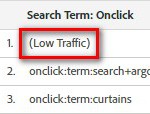So you’ve seen “Low Traffic” in a report? It might look something like:
When looking at Adobe Reports & Analytics if there are too many unique values for a dimension they won’t all be shown in reporting. That doesn’t mean to say the data is lost as our data warehouse will still store them all.
Adobe Reports & Analytics
If a report has less than 500,000 unique values in a month all will be available in reporting. Let’s say for example over the course of a month there are 500,000 different search terms made on our website, you would be able to see every single term and the number of times those terms were searched for in the “Search Term: Onclick (eVar4)” report.
Remember it’s the value that’s captured not the number of times it happens so even if there were a billion searches made on our website as long as there isn’t more than 500,000 unique search terms you’d see every single one in the report.
If on the other hand there were more than 500,000 unique values in a dimension Adobe would apply some logic to determine whether or not to show them:
- As mentioned above if a value is already in the report just add an instance to that value so everything would be captured.
- If a value is not yet in reporting, check to see if that value was seen more than approximately ten times today. If it has, add this value to reporting. If it hasn’t been counted more than about ten times, leave it under (Low-Traffic). So if for example we’d exceeded 500,000 unique values half way through the month but then launched a new product, as long as it was searched for at least 10 times in any given day for the rest of the month, it would still appear in reporting
If a report suite reaches more than 1,000,000 unique values, more aggressive filtering is applied:
- As mentioned above if a value is already in the report just add an instance to that value so everything would be captured.
- If a value is not yet in reporting, check to see if that value was seen more than approx. 100 times today. If it has, add the value to reporting. If it hasn’t, leave it under (Low-Traffic).
The one caveat to the logic when we exceed 500,000 unique values is that if the value was seen less than 10 times in the day on a Monday for example but more than 10 times on the Tuesday the number of instances of it wouldn’t move out of “Low Traffic” so you would see 0 against that value on the Monday and whatever the total number of instances were on the Tuesday.
Data Warehouse
Data Warehouse stores all unique values for most variables, regardless of the number of unique values. So even if we did have more than 500,000 unique search terms for example we would still be able to run a data warehouse request to return them all.
If is however, still possible to see a (Low-Traffic) line item in data warehouse with some of the following variables:
- Variables that can contain multiple values, such as list vars and list Props
- TNT and Survey variables
- Some Marketing Channel variables such as First/Last Touch Detail
- Merchandising eVars
